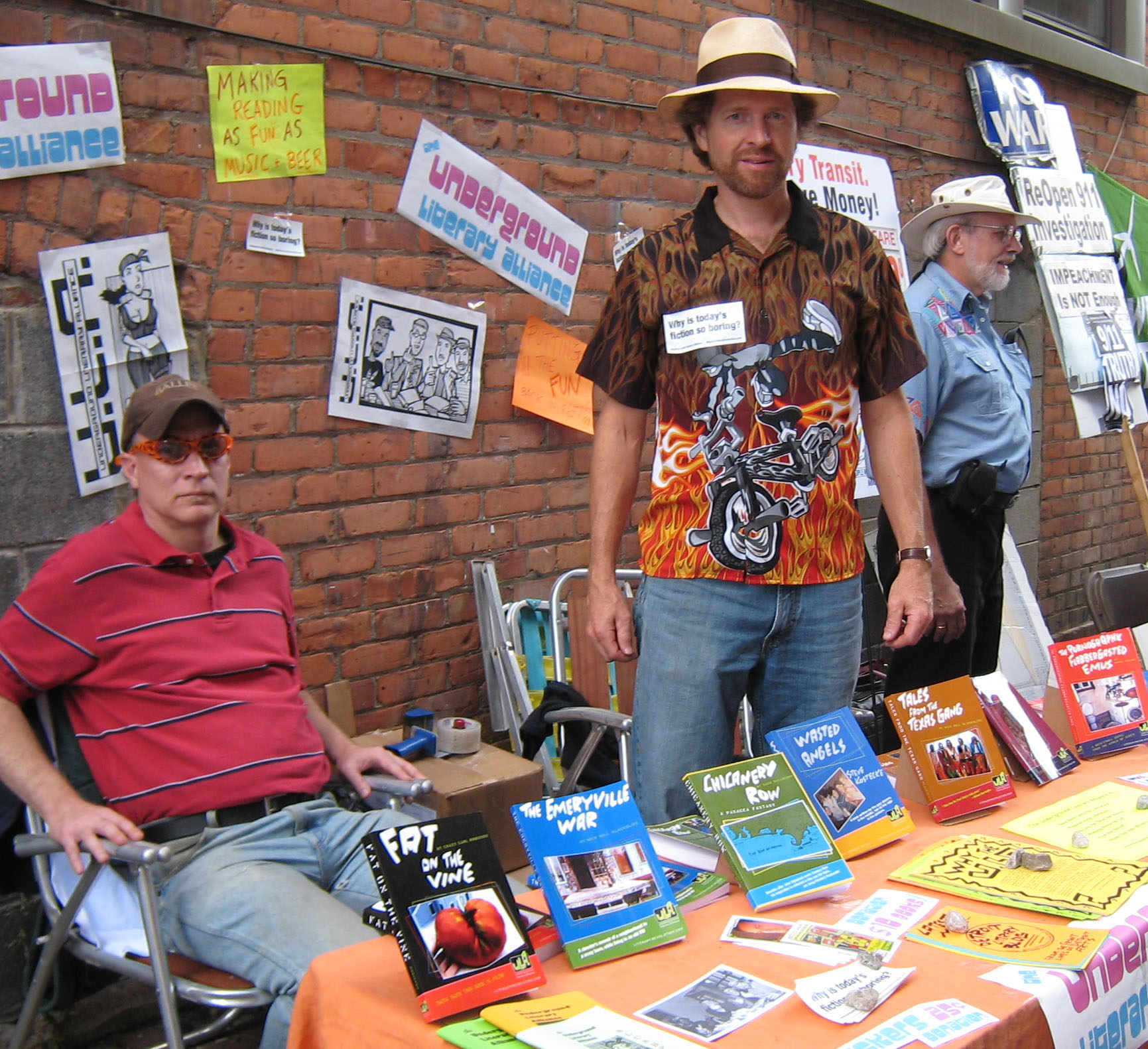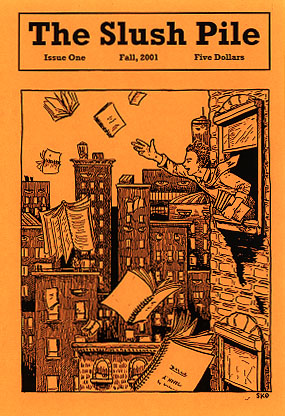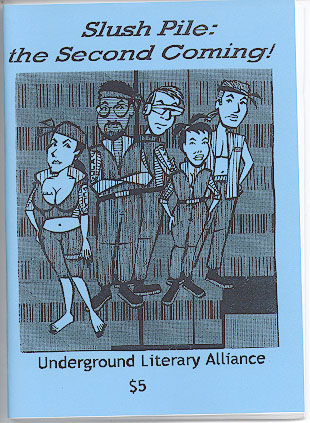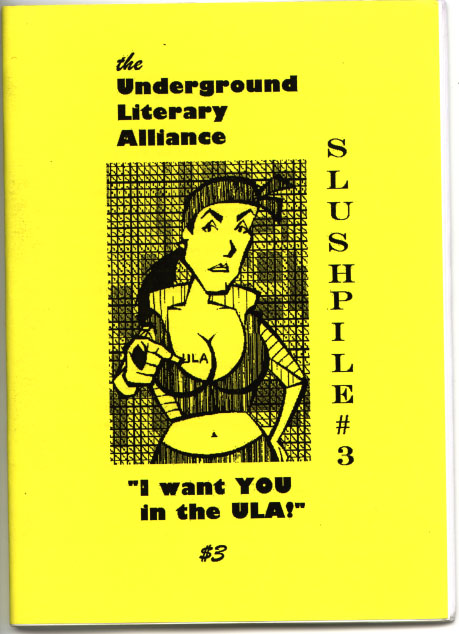More Photos Below!Gallery
As you may know, as part of my effort to promote indy culture, I work with the ULA and publish a line of indy novels that seek to break the boring deathgrip that academia and NYC have on literature. This liberation quest is even tougher than my efforts to keep the outdoor sports people hooked up to their roots.
I know that the outdoor culture buffs who read OYB also read literary things (and listen to music), but so far it seems like I’ve been unable to get much results from my efforts to connect outdoor culture with wider culture. Hemingway had better luck at it. Jim Harrison does good at it, too. Trout fishing and sailing are classic areas where culture and sport merge. In “Dirt Rag” magazine the mtbikers cross-over with every issue into beer and music. Obviously, it all goes together. Untold thousands of outdoorsmen made their first discoveries of “big culture” thanks to the likes of ol’ Hem and Jack London. Well, times change and new times need new connections so someone better keep up the effort. (Fear not, I have a trick up my sleeve: a new website design that will have you getting into OYBish indy culture stuff of all kinds. I’m going to display multiple kinds of stories and goodies in every window! You won’t be able to hide out in one topic much longer!)
Contemporary art that integrates with the outdoor action side of real life in an everyday way is not the easiest to find, and I don’t see many others doing this kind of wide-ranging hook-up thing. But I’m not just doing this for outdoor folk. OYB is bigger than that. So is the ULA. I’m interested in showing indy people in general, who are used to seeing the rockin’ indy music and film, that literature hasn’t been forgotten—and that outdoor action in particular is a great venue for expressing culture. Hinterlands people shouldn’t forget culture—and city folk shouldn’t downplay the hinterlands. It’s a tough two-way project!
But it’s bigger than that even. It’s a triple goal. The biggest challenge is to show the general population the overall relevance of grassroots culture.
So, I published a series of ULA novels that are far more real-world, “hands-on,” workingclass, everyday, street in their origins than other lit out there.
And with this challenge in mind, I look for public events to get tables at to spread the word about everyday everybody liberation.
In late winter I do an outdoor expo show. Then earlier this summer I got a table at the Allied Media Conference (AMC) radical media conference in Detroit.
Karl Wenclas, an indy lit cohort, helped give my ULA table some pizzaz at the AMC show. But he said there was another event in Detroit that would be much better—the Dally in the Alley. He said it’s a huge indy arts block party in the Cass Corridor that has 10,000 people—and that the ULA message would stand out and find allies in the diverse crowd. So I looked into it and hooked up with its casual, friendly organizers and got a table.
The Dally in the Alley started as a block party 31 years ago and has grown just a wee bit. It’s still a block party, but it includes all the roads and intersections and all the alleys on the interior of the block. There are 4 music stages, a street of food booths, beer and wine booths, and streets and alleys full of arts and trinket booths. People have garage-sale-like displays with used books and clothes.
You may be aware that the Cass Corridor used to be Murder Central of Murder City USA — it has made the turn-around. I note that Detroit may well have the cheapest rent of any US metro area. This might be the #1 key to turning the city around. Cheap rent draws creative types which then revives a city. Where hasn’t it worked out this way? Of course, in a couple decades the artists are then driven out by higher rents. Heck, Detroit even has cheap mansions in neighborhoods that are now reclaimed — all close to the major city amenities. It’s ripe for a major turnaround!
I arrived early and was given a prime spot. I set up my sweet ULA display and met a bunch of friendly booth neighbors.
The traffic and action built up all day long, bigger and bigger.
Young and old of all kinds and colors flowed on by. Dozens of folks stopped to talk and engage me about the ULA quest for literary liberation.
Karl showed up in the afternoon and joined in the fun. He’s a great salesman. We put up a sign that declared our mission: “Making Reading as Fun as Music and Beer!”
For the first time, the ULA has a coherent range of books to sell, that present a united image of liberation and fun. We also had zeens, literary action-hero trading cards and stickers. Something for every interest and price range.
We sold dozens of books to obviously idea-thirsty folks—mostly young people. We met a bunch of writers—some young ones, one tough professional, a few college professors. We were up for any engagement. We were an exciting tag-team for literature. Karl put on a pair of blinking orange and black Tigers baseball sunglasses—which actually drew people to our table.
I got a kick out of all the young people who hooked up with our ideas with their big eyes. I really hope I hear back from them. I recall a hooded Black Muslim lady who read some of our wildest back cover matter without batting an eye. She said we reminded her of Donald Goines, the famous black ghetto writer. Rockin! Cross the lines.
We’d take breaks and sight-see. Two times people stopped me and took pics of my BMX-flames shirt with a “Why is today’s fiction so boring?” sticker on it. That was fun—the message and style was catching on.
Man, the music was good!
As it got dark we thought that people might stop responding to our message, but it was weird: we fit right in with the party. People kept stopping by and engaging us…and buying books! Actually drunk people obviously couldn’t focus their eyes much less their minds. But people who just wanted some excitement could easily see the point of what we were doing.
The Dally was great fun. We connected with a bunch of non-literary people. And a wide variety of literary people, too, from a wide range of cultures. The goal is to get word of mouth going for DIY lit out there among everyday people. Literature is for them! That’s my goal when I have a book table at a big party…and when I show novels to outdoor people here at OYB.
Some librarian or schoolmarm types would stop and say “But reading isn’t boring!” We’d say, “Right! But how many people know that? There is a lot of good stuff out there, but there’s a disconnect. The whole zine revolution was IGNORED by the lit scene! Some of it was really good.” They were easy to hook over to our side. We’re not saying to get rid of the fancy lads and academia. We say just don’t forget the street!
The intellectuals are reading already. But brainy folks have been turned into just another shopping demographic. Lit hates niches. Our segregating system needs to be busted open!
Everyday people need to read Lit as much as anyone. Why? To live! Reading is the King art for the Queen muse, Memory. Reading really does matter! But people have to FEEL that in their bones. They need reading that hits for it to work and stick. Reading is how people can know what their options are in a particular culture, it’s how culture knows and explores itself. People can more readily connect their particular scene to the rest of culture THRU something like street lit. Folk writing brings people around to Shakespeare and Plutarch and even the postmodernists by showing how it all fits together.
Vernacular writing may not have polish but it’s just as full of ideas and life. Plain folks appreciate talent. It’s just not where or what they’re told it is. They can’t be fooled! They’ll turn to TV instead. Elitists look down on them, but really the plain folk know the score when they see it. Because it will hit them in a relevant way. The fancy folk are the real fools, in the end. It’s the old hillbilly reversal.
Face it, a lot of what passes as lit today has blinders on, has biases that cut audiences off, that cater to small groups, to identity groups, to particular social classes. Street lit has the brains, muscle and boldness to aim higher, to connect back to the old greats and point forward to today’s potential.
Like Karl told a pro writer who engaged us, when a scene gets too much into polish and refinement it turns into Emerson, Lake and Palmer—which spurs the advent of punk! Punk wasn’t everything, but it was needed. It couldn’t be stopped. It forged its own new pathways when the existing options rejected it.
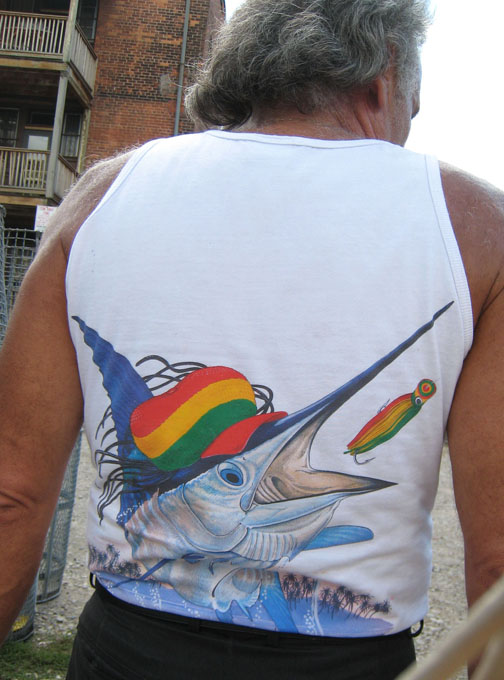
This guy’s t-shirt seems to offer a somewhat complex level of nuttiness.
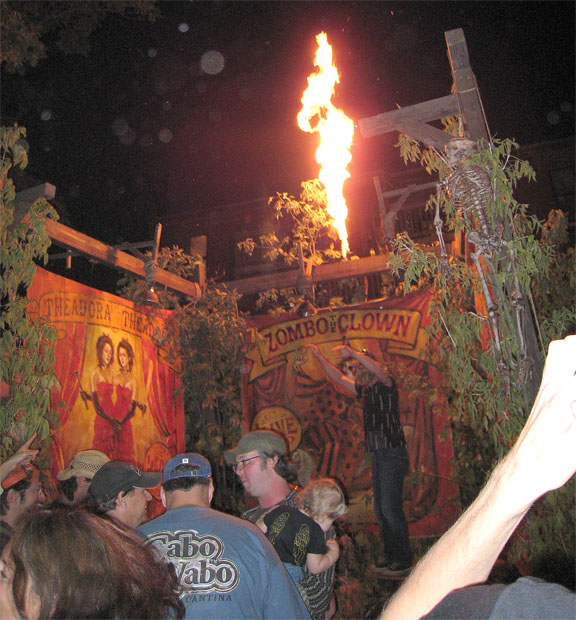
Every few minutes the Freak Show would flame up.
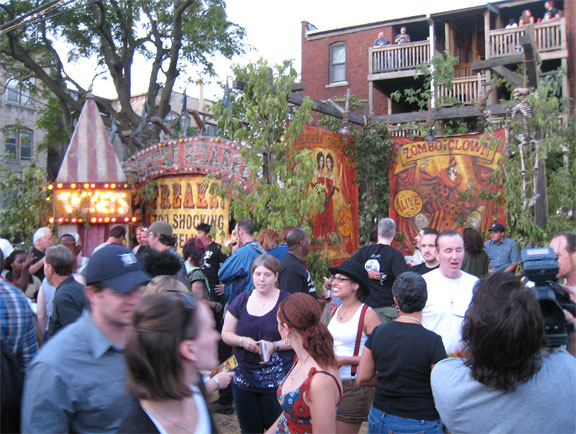
The Freak Show booth was very elaborate.
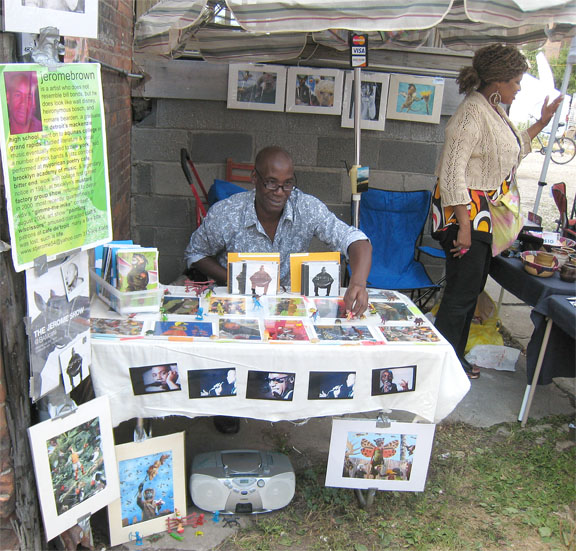
Neat collage artist—and musician.
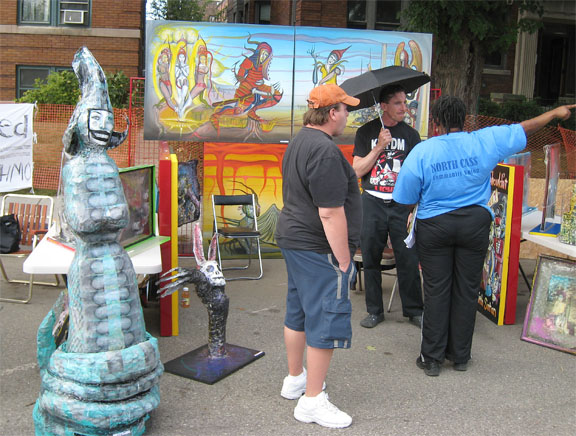
Far-out art booth.
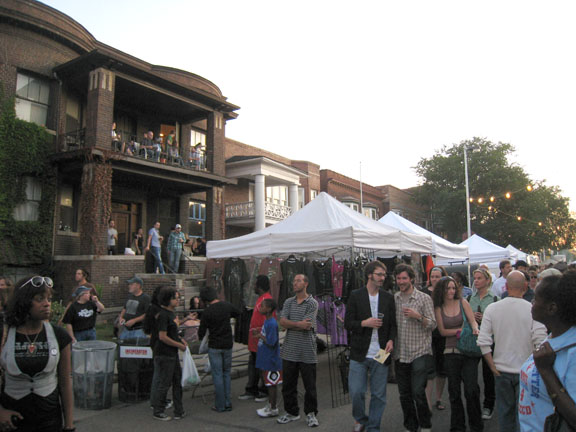
Street life. I really liked all the double-decker porches and quality brick alleys.
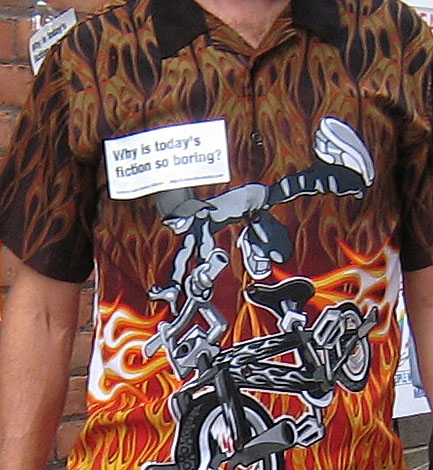
My shirt and sticker. People kept taking pics of it.
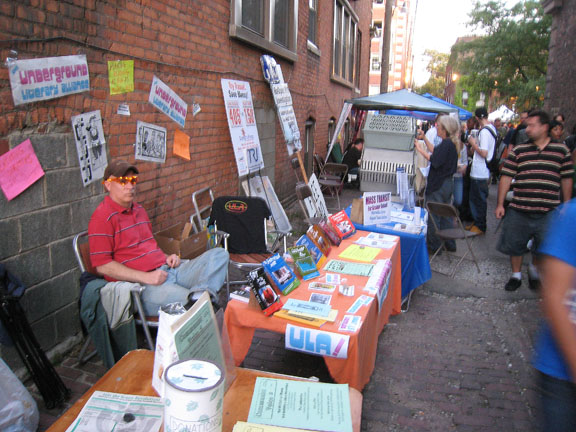
Here you can see Karl’s highpowered Tigers glasses lighting up. Literature needs more carnival barker style. It worked!
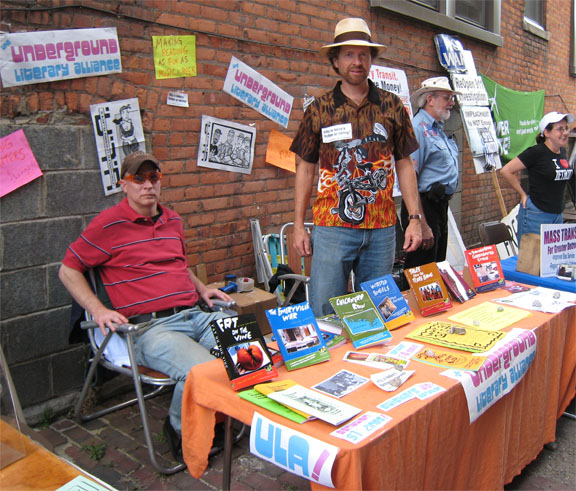
Here we are in our alley scene.
